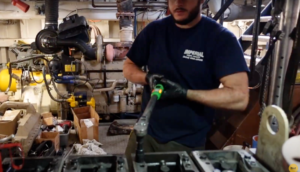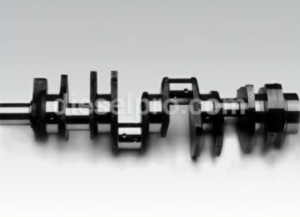
Maintaining and overhauling the Cummins KTA19 engine requires not just technical knowledge but also the right set of special tools and service equipment. While basic hand tools are sufficient for minor tasks, complex repairs like engine disassembly, timing adjustments, and calibration demand specialized equipment designed to ensure precision, efficiency, and safety. This comprehensive guide will walk you through the must-have tools, specialty equipment, and best practices for working on the Cummins KTA19.
Parts Catalog for Cummins KTA19 Marine Engine
Tools & Related Components for Cummins KTA19 Engine
Must-Have Tools for Cummins KTA19 Repairs

The Cummins KTA19 is a heavy-duty engine commonly used in marine, industrial, and power generation applications, making it critical to have the right tools for both routine maintenance and complete overhauls. Here’s a breakdown of the must-have tools:
1. Basic Hand Tools
While specialized tools are essential, you’ll still need a complete set of high-quality basic hand tools for general disassembly and reassembly tasks:
- Metric and SAE socket sets (including deep sockets for hard-to-reach bolts)
- Combination wrenches (ratcheting wrenches improve efficiency)
- Screwdrivers (flathead and Phillips in various sizes)
- Pry bars and breaker bars for loosening stubborn fasteners
- Allen wrenches (hex keys) and Torx bits
Investing in durable, professional-grade tools ensures reliability, especially when working on heavy-duty components.
2. Torque Wrenches
Proper torque application is critical when assembling the KTA19 to prevent over-tightening or under-tightening, which can lead to mechanical failures. Essential torque tools include:
- Click-type torque wrenches for general bolt tightening
- Dial-type torque wrenches for high-precision applications
- Angle torque gauges for torque-to-yield bolts (used on components like cylinder heads and main bearings)
Ensure your torque wrenches are calibrated regularly to maintain accuracy.
Essential Tools for Disassembly and Reassembly

Disassembling and reassembling the Cummins KTA19 requires tools designed to handle large, heavy components safely and efficiently.
1. Engine Hoist or Crane
The KTA19’s components, such as the cylinder head, crankshaft, and turbocharger, are extremely heavy. A hydraulic engine hoist or overhead crane with a load capacity of at least 2 tons is necessary for:
- Lifting the engine from the chassis or engine bay
- Removing heavy parts like the crankshaft, cylinder heads, and flywheel
- Positioning components accurately during reassembly
Always use proper lifting chains or straps rated for heavy-duty engines, and attach them to designated lifting points to prevent damage.
2. Engine Stand
An adjustable engine stand designed to support the Cummins KTA19 is crucial for stability during overhauls. It allows the engine to be rotated, giving you access to all sides for:
- Removing pistons and connecting rods
- Inspecting crankshaft journals
- Cleaning and reassembling components
Ensure the stand is rated for heavy engines (minimum capacity of 2,000 lbs) and features secure locking mechanisms for safety.
3. Piston Ring Compressor
A piston ring compressor is required when installing new pistons into the cylinder liners. It compresses the piston rings to prevent damage to the rings or liner walls during insertion. Use a tapered ring compressor for the best results, as it allows smoother installation without ring distortion.
4. Bearing Pullers and Installers
Specialized bearing pullers are necessary to remove:
- Crankshaft main bearings
- Camshaft bearings
- Auxiliary drive bearings
When reinstalling, use bearing drivers or installers to ensure the bearings are seated properly without applying uneven pressure, which could cause premature wear or failure.
Specialty Tools for Timing and Calibration

The Cummins KTA19 relies on precise timing and calibration for optimal performance. Even slight misalignments can cause poor combustion, increased emissions, and engine damage.
1. Timing Pin and Alignment Tools
A timing pin set ensures the proper alignment of the crankshaft, camshaft, and fuel pump gears during both disassembly and reassembly. These tools lock the components in place, preventing unintentional movement when adjusting or replacing timing gears.
2. Dial Indicator with Magnetic Base
A dial indicator is essential for checking:
- Top Dead Center (TDC) when setting valve timing
- Camshaft lift and runout
- Crankshaft end play
The magnetic base provides a stable platform for accurate measurements, even on uneven surfaces.
3. Injector Height Gauge
For fuel system calibration, an injector height gauge is used to set the precise distance between the injector plunger and the camshaft. Incorrect injector height can cause poor fuel atomization, reduced efficiency, and potential engine knock.
4. Fuel Pump Timing Tool Kit
When servicing or replacing the fuel pump, a timing tool kit helps:
- Lock the fuel pump in the correct position
- Align timing marks accurately
- Ensure proper synchronization with the camshaft and crankshaft
Incorrect fuel pump timing leads to misfires, hard starts, and excessive smoke.
Custom Fixtures for Overhaul Efficiency
Using custom fixtures and jigs designed for the KTA19 improves efficiency and safety during overhauls.
1. Cylinder Liner Puller and Installer

The KTA19 often uses wet cylinder liners, which require specialized tools for removal and installation:
- A liner puller extracts liners without damaging the engine block.
- A liner installer ensures the new liner seats correctly with proper protrusion measurements.
Incorrect installation can result in coolant leaks, compression loss, or premature liner wear.
2. Crankshaft Support Fixture

A crankshaft support fixture holds the crankshaft securely during inspection and repair. This prevents damage to the journals and simplifies tasks like:
- Measuring bearing clearances
- Checking for straightness
- Polishing crankshaft surfaces
3. Valve Spring Compressor

The valve spring compressor allows for the safe removal and installation of valve springs, retainers, and locks. This tool is crucial when servicing the cylinder head, performing valve lapping, or replacing worn valve seals.
Using Engine Stands, Lifting Devices, and Alignment Tools
1. Engine Stands
When mounting the KTA19 on an engine stand, ensure:
- The stand is rated for the engine’s weight (often exceeding 1,500 lbs).
- It has a rotating head to allow easy access to all sides.
- The mounting arms are securely bolted to engine lifting brackets.
2. Lifting Devices
Hydraulic lifts and overhead cranes are essential for:
- Removing the engine from the chassis
- Handling large components like the flywheel, cylinder head, and turbocharger
- Safely rotating the engine during overhauls
Always inspect lifting chains, slings, and hooks for wear before use.
3. Alignment Tools
Proper alignment tools ensure:
- Correct crankshaft-to-camshaft timing
- Precise gear meshing during reassembly
- Alignment of flywheel housing and bellhousing for transmission installation
Misalignment can lead to excessive vibration, gear wear, and engine imbalance.
Safety Considerations When Using Heavy Equipment


Working with heavy engines like the KTA19 involves significant safety risks. Here are essential safety guidelines:
1. Personal Protective Equipment (PPE)
- Safety Glasses: Protect your eyes from debris, splashes, and metal shavings.
- Steel-Toe Boots: Prevent foot injuries from falling objects.
- Gloves: Use cut-resistant gloves when handling sharp or rough components.
- Hearing Protection: Wear earplugs or earmuffs when working near loud equipment.
2. Safe Lifting Practices
- Never exceed the rated capacity of hoists, cranes, or stands.
- Inspect lifting equipment before each use for signs of wear, corrosion, or damage.
- Use proper lifting techniques—keep the load balanced and secure.
- Never stand under a suspended load.
3. Handling Pressurized Systems
When working with pressurized systems like fuel lines or cooling systems:
- Relieve system pressure before disassembly.
- Wear face protection to prevent injuries from pressurized fluid sprays.
- Use proper fittings and hoses rated for the required pressure.
4. Fire Safety
- Keep a fire extinguisher nearby when working with flammable fuels or oils.
- Avoid smoking or using open flames near fuel systems.
- Clean up oil spills immediately to prevent slip hazards and fire risks.
Disclaimer
The use of specialized tools for the Cummins KTA19 requires proper training and technical knowledge. Always follow the tool manufacturer’s instructions and Cummins service guidelines to ensure safe and accurate repairs. Failure to use the correct tools or follow safety protocols can result in serious injury, equipment damage, or engine failure.
Parts Catalog for Cummins KTA19 Marine Engine
Tools & Related Components for Cummins KTA19 Engine



 Free US Calls: 1-888-433-4735
Free US Calls: 1-888-433-4735 International: 305-545-5588
International: 305-545-5588